Applications of Energy-Based Evaluation Method of Element Importance to Grid Structures
Abstract
:1. Introduction
2. Evaluation Method of Element Importance
2.1. Hypothesis
- Only linear elasticity and geometric nonlinearity are introduced in the analysis, while material damage and structural stability are not taken into account.
- The topological relationship will be modified by the conceptual removal method in the numerical simulation for the initial damage. The additional load and dynamic effects induced by falling and explosion are not included.
- In the event of an accident, the structure is rarely damaged by earthquake and wind loads simultaneously. As a result, only the vertical nodal load is taken into the evaluation.
- The external loads at the nodes are not affected by the failure of elements in the grid structures.
2.2. Element Importance Coefficient
2.3. Flow Chart of the Method
3. Element Importance of Square Pyramid Space Grid Structures
4. Influence of Load Pattern and Geometry
4.1. Effects of Load Patterns
4.2. Influence of the Support Conditions
4.3. Influence of the Span
4.4. Influence of Sizes of the Basic Pyramid Grid
5. Effects of the Spatial Grid Topology
5.1. Diagonal Square Pyramid Grids
5.2. Bi-Orthogonal Lattice Grids
5.3. Bi-Orthogonal-Diagonal Lattice Grids
6. Conclusions
- (1)
- For square pyramid grid structures, the results show that the lower and top chords are more important than the diagonal web members. The importance coefficients of the elements are different under different load patterns, and the order of importance of the elements is also changed when subjected to horizontal loads.
- (2)
- The change of the support condition reduces the importance of the upper and lower chords in the center area for square pyramid grid structures. The effects of the structural span and the size of the basic pyramid grid can be ignored for the location of the most important members.
- (3)
- There are different distribution characteristics for the element importance coefficients for grid structures with different topologies. The location of important elements for the upper chords, the lower chords and the web members are dependent on the relationship between the arrangement of these members and support sides.
Author Contributions
Funding
Institutional Review Board Statement
Informed Consent Statement
Data Availability Statement
Acknowledgments
Conflicts of Interest
References
- Ameri, M.R.; Massumi, A.; Masoomi, H. Effect of structural redundancy on progressive collapse resistance enhancement in RC frame structures. J. Perform. Constr. Facil. 2019, 33, 04018092. [Google Scholar] [CrossRef]
- Mucedero, G.; Brunesi, E.; Parisi, F. Progressive collapse resistance of framed buildings with partially encased composite beams. J. Build. Eng. 2021, 38, 102228. [Google Scholar] [CrossRef]
- Kang, S.; Tan, K.H. Behaviour of precast concrete beam–column sub-assemblages subject to column removal. Eng. Struct. 2015, 93, 85–96. [Google Scholar] [CrossRef]
- Feng, J.; Sun, Y.; Xu, Y.; Wang, F.; Zhang, Q.; Cai, J. Robustness analysis and important element ealuation method of truss structures. Buildings 2021, 11, 436. [Google Scholar] [CrossRef]
- Feng, J.; Ren, S.; Zhang, Q.; Xu, Y.; Li, J.; Cai, J. Numerical investigation on the buckling behavior of damaged steel members constrained by outer tubes. Structures 2021, 34, 1068–1079. [Google Scholar] [CrossRef]
- Foraboschi, P. Versatility of steel in correcting construction deficiencies and in seismic retrofitting of RC buildings. J. Build. Eng. 2016, 8, 107–122. [Google Scholar] [CrossRef]
- Meloni, M.; Cai, J.; Zhang, Q.; Lee, S.-H.D.; Li, M.; Ma, R.; Parashkevov, T.E.; Feng, J. Engineering Origami: A comprehensive review of recent applications, design methods, and tools. Adv. Sci. 2021, 8, 2000636. [Google Scholar] [CrossRef]
- Zhang, Q.; Pan, N.; Meloni, M.; Lu, D.; Cai, J.; Feng, J. Reliability analysis of radially retractable roofs with revolute joint clearances. Reliab. Eng. Syst. Saf. 2021, 208, 107401. [Google Scholar] [CrossRef]
- Shayanfar, M.A.; Javidan, M.M. Progressive collapse-resisting mechanisms and robustness of RC frame-shear wall structures. J. Perform. Constr. Facil. 2017, 31, 04017045. [Google Scholar] [CrossRef]
- Stephen, D.; Lam, D.; Forth, J.; Ye, J.; Tsavdaridis, K.D. An evaluation of modelling approaches and column removal time on progressive collapse of building. J. Constr. Steel Res. 2019, 153, 243–253. [Google Scholar] [CrossRef]
- Elsanadedy, H.M. New moment-resisting beam-column joints to increase progressive collapse resistance of precast concrete buildings. J. Build. Eng. 2021, 44, 102884. [Google Scholar] [CrossRef]
- Fu, F.; Parke GA, R. Assessment of the progressive collapse resistance of double-layer grid space structures using implicit and explicit methods. Int. J. Steel Struct. 2018, 18, 831–842. [Google Scholar] [CrossRef]
- Tian, L.; Wei, J.; Hao, J. Anti-progressive collapse mechanism of long-span single-layer spatial grid structures. J. Constr. Steel Res. 2018, 144, 270–282. [Google Scholar] [CrossRef]
- Wei, J.; Tian, L.; Hao, J. Improving the progressive collapse resistance of long-span single-layer spatial grid structures. Constr. Build. Mater. 2018, 171, 96–108. [Google Scholar] [CrossRef]
- Adam, J.M.; Parisi, F.; Sagaseta, J.; Lu, X. Research and practice on progressive collapse and robustness of building structures in the 21st century. Eng. Struct. 2018, 173, 122–149. [Google Scholar] [CrossRef]
- Pandey, P.C.; Barai, S.V. Structural sensitivity as a measure of redundancy. J. Struct. Eng. ASCE 1997, 123, 360–364. [Google Scholar] [CrossRef]
- Agarwal, J.; Blockley, D.; Woodman, N. Vulnerability of structural systems. Struct. Saf. 2003, 25, 263–286. [Google Scholar] [CrossRef]
- Wu, X.; Blockley, D.I.; Woodman, N.J. Vulnerability of structural systems.2. failure scenarios. Civ. Eng. Syst. 1993, 10, 319–333. [Google Scholar] [CrossRef]
- Wu, X.; Blockley, D.I.; Woodman, N.J. Vulnerability of structural systems.1. rings and clusters. Civ. Eng. Syst. 1993, 10, 301–317. [Google Scholar] [CrossRef]
- Beeby, A.W.; Institution, O.S.E. Safety of structures, and a new approach to robustness. Struct. Eng. 1999, 77, 16–21. [Google Scholar]
- Gharaibeh, E.S.; Frangopol, D.M.; Onoufriou, T. Reliability-based importance assessment of structural members with applications to complex structures. Comput. Struct. 2002, 80, 1113–1131. [Google Scholar] [CrossRef]
- Izzuddin, B.A.; Vlassis, A.G.; Elghazouli, A.Y.; Nethercot, D.A. Progressive collapse of multi-storey buildings due to sudden column loss—Part I: Simplified assessment framework. Eng. Struct. 2018, 30, 1308–1318. [Google Scholar] [CrossRef] [Green Version]
- Nafday, A.M. System safety performance metrics for skeletal structures. J. Struct. Eng. -ASCE 2008, 134, 499–504. [Google Scholar] [CrossRef]
- Gao, Y.; Liu, X. Importance coefficients of components in evaluation of structure robustness. Chin. J. Rock Mech. Eng. 2008, 27, 575–2584. (In Chinese) [Google Scholar]
- Khandelwal, K.; El-Tawil, S. Pushdown resistance as a measure of robustness in progressive collapse analysis. Eng. Struct. 2011, 33, 2653–2661. [Google Scholar] [CrossRef]
- Brunesi, E.; Nascimbene, R.; Parisi, F.; Augenti, N. Progressive collapse fragility of reinforced concrete framed structures through incremental dynamic analysis. Eng. Struct. 2015, 104, 65–79. [Google Scholar] [CrossRef]
- Li, Y.; Lu, X.; Guan, H.; Ren, P.; Qian, L. Probability-based progressive collapse-resistant assessment for reinforced concrete frame structures. Adv. Struct. Eng. 2016, 19, 1723–1735. [Google Scholar] [CrossRef]
- Gordini, M.; Habibi, M.R.; Sheidaii, M.R.; Tahamouliroudsari, M. Reliability analysis of double-layer domes with stochastic geometric imperfections. Adv. Comput. Des. 2017, 2, 133–146. [Google Scholar] [CrossRef]
- Cai, J.; Jia, W.; Feng, J.; Wang, F.; Xu, Y. Applications of stiffness-based evaluation method to element importance of truss systems. J. Civ. Eng. Manag. 2017, 23, 562–572. [Google Scholar] [CrossRef]


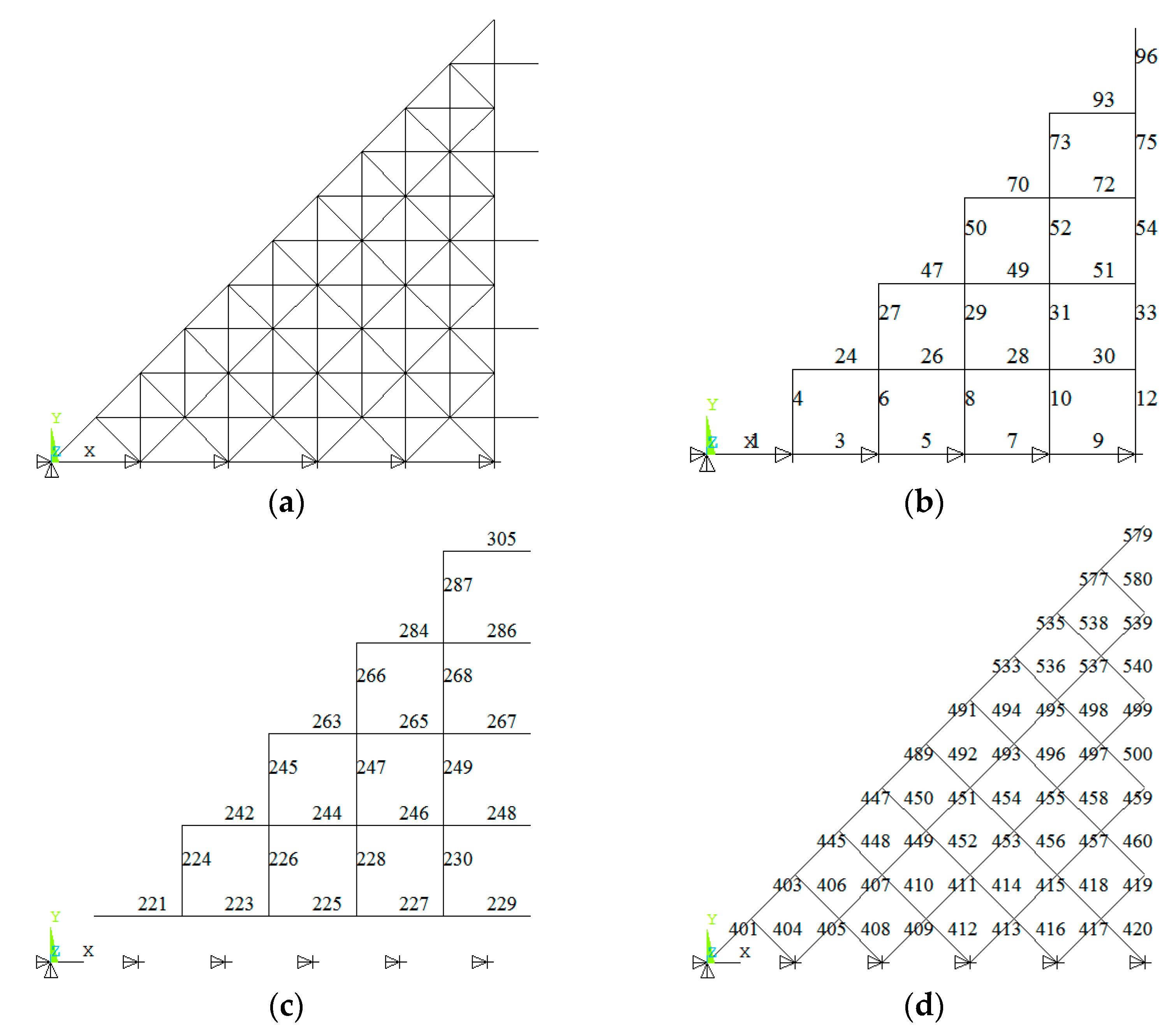
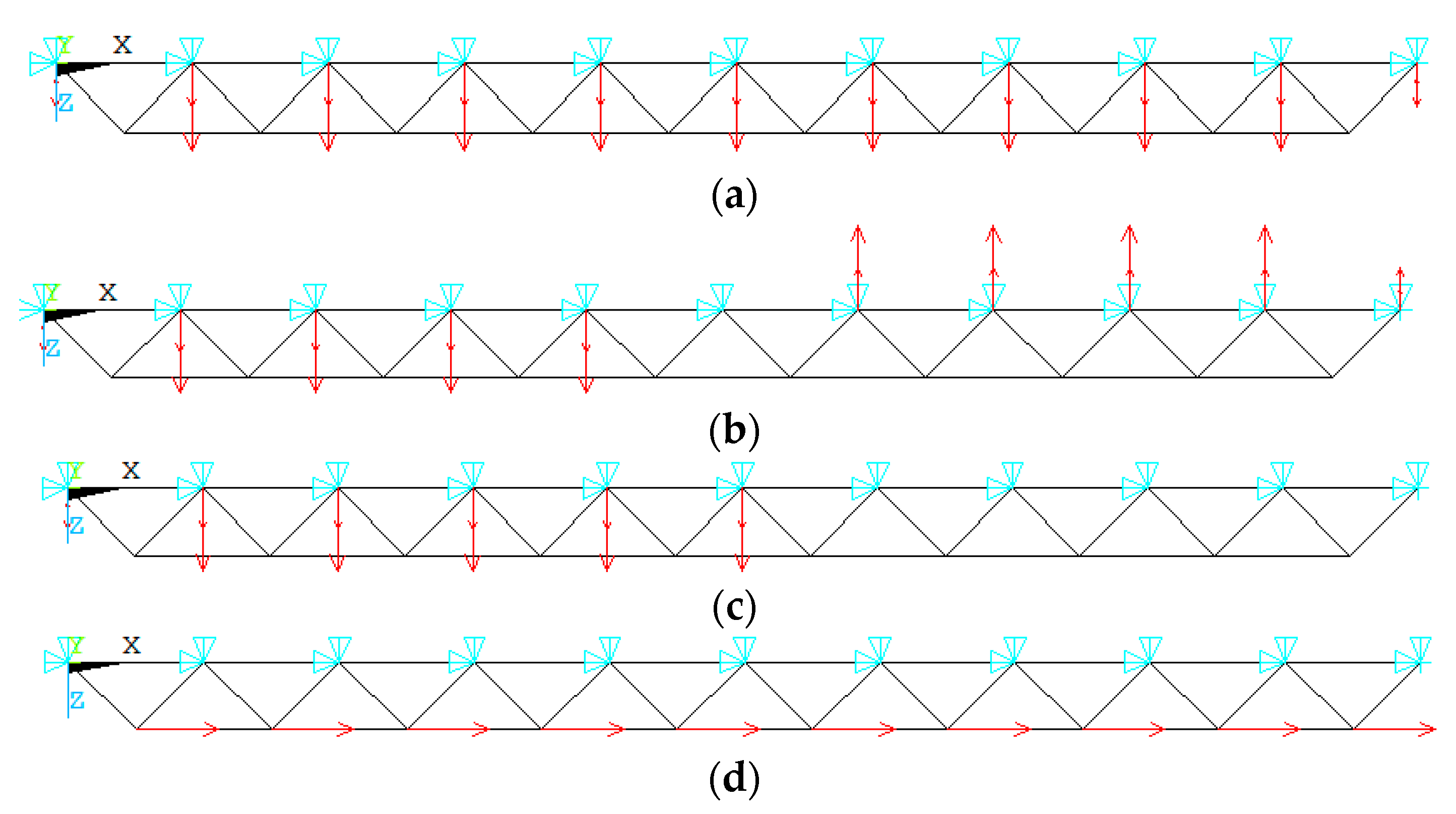



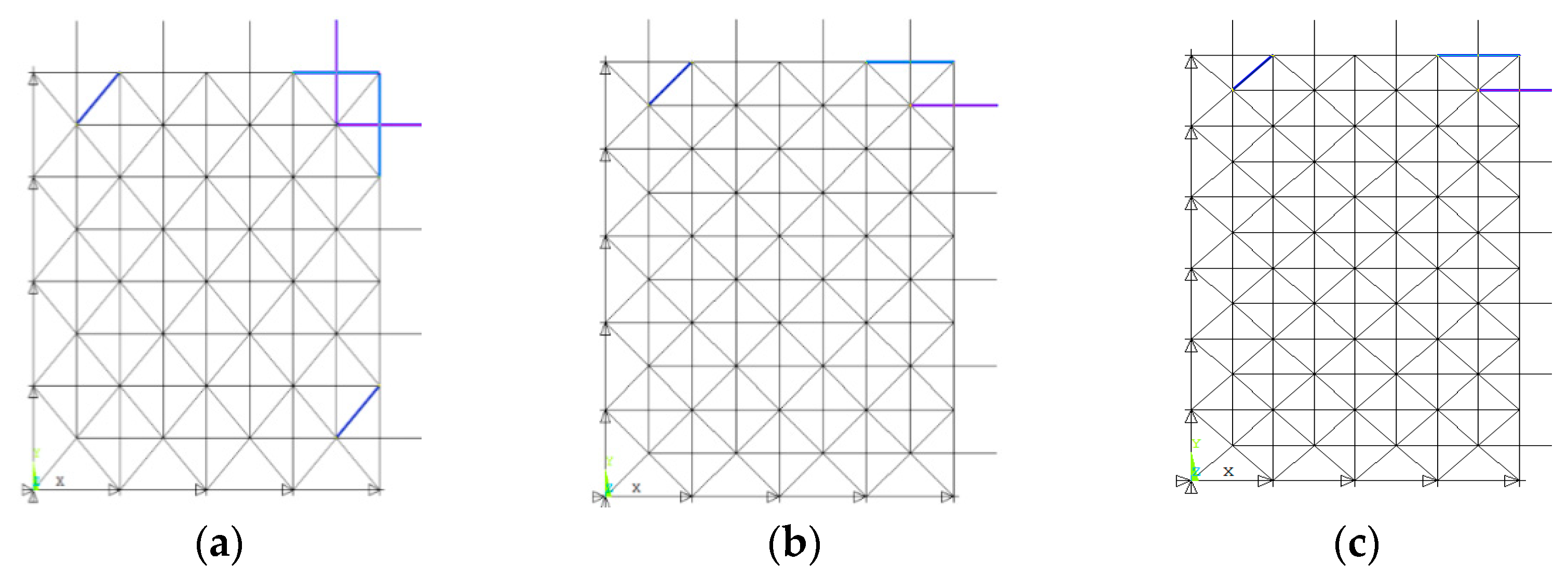
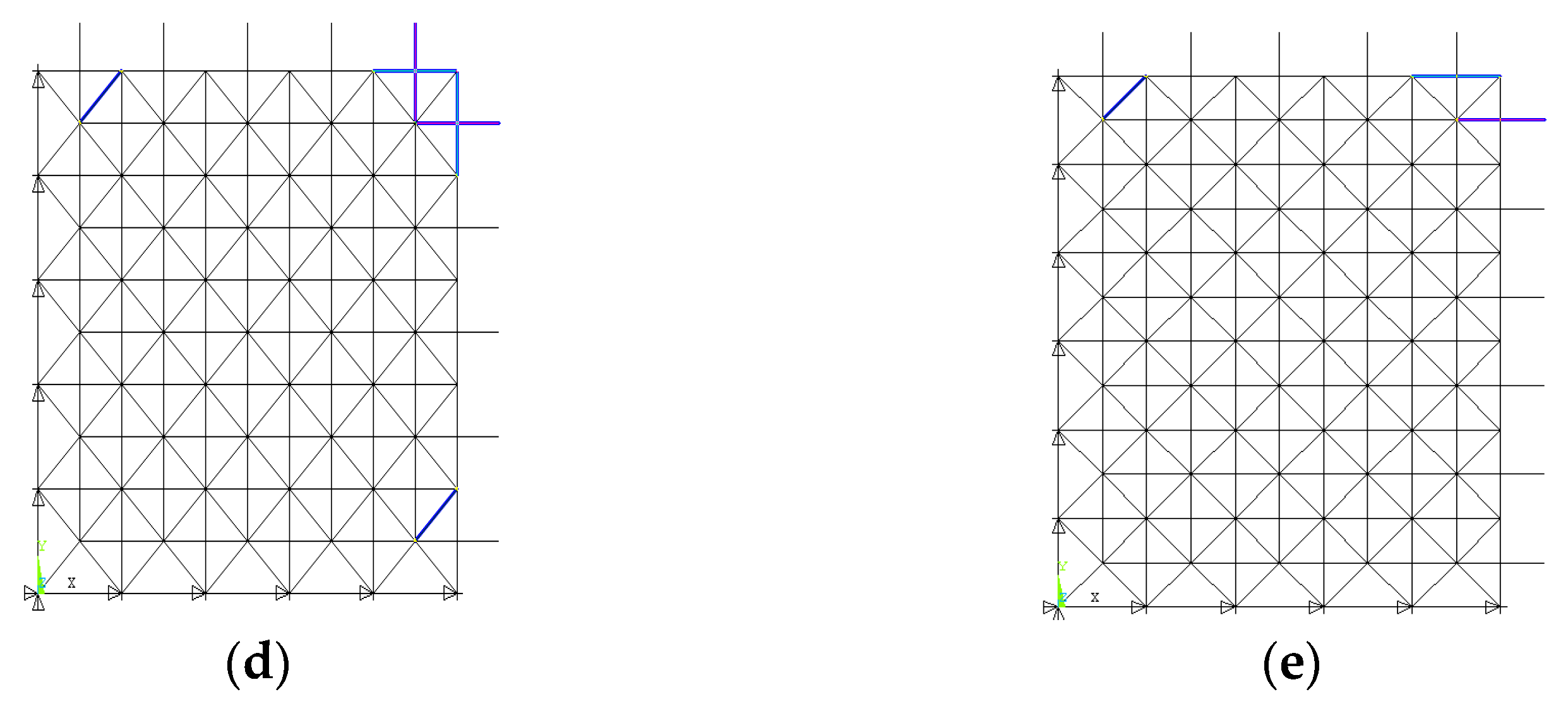
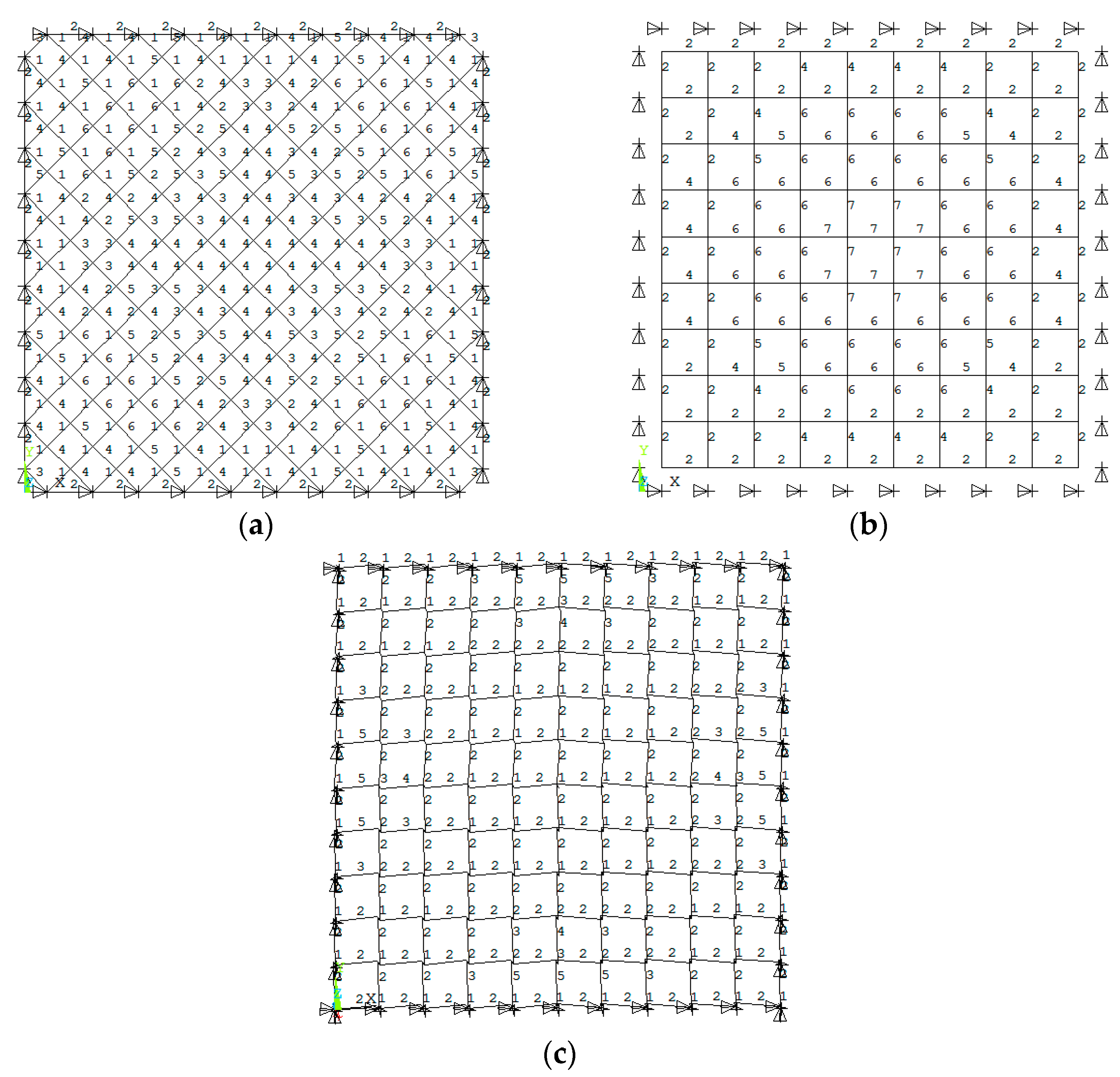
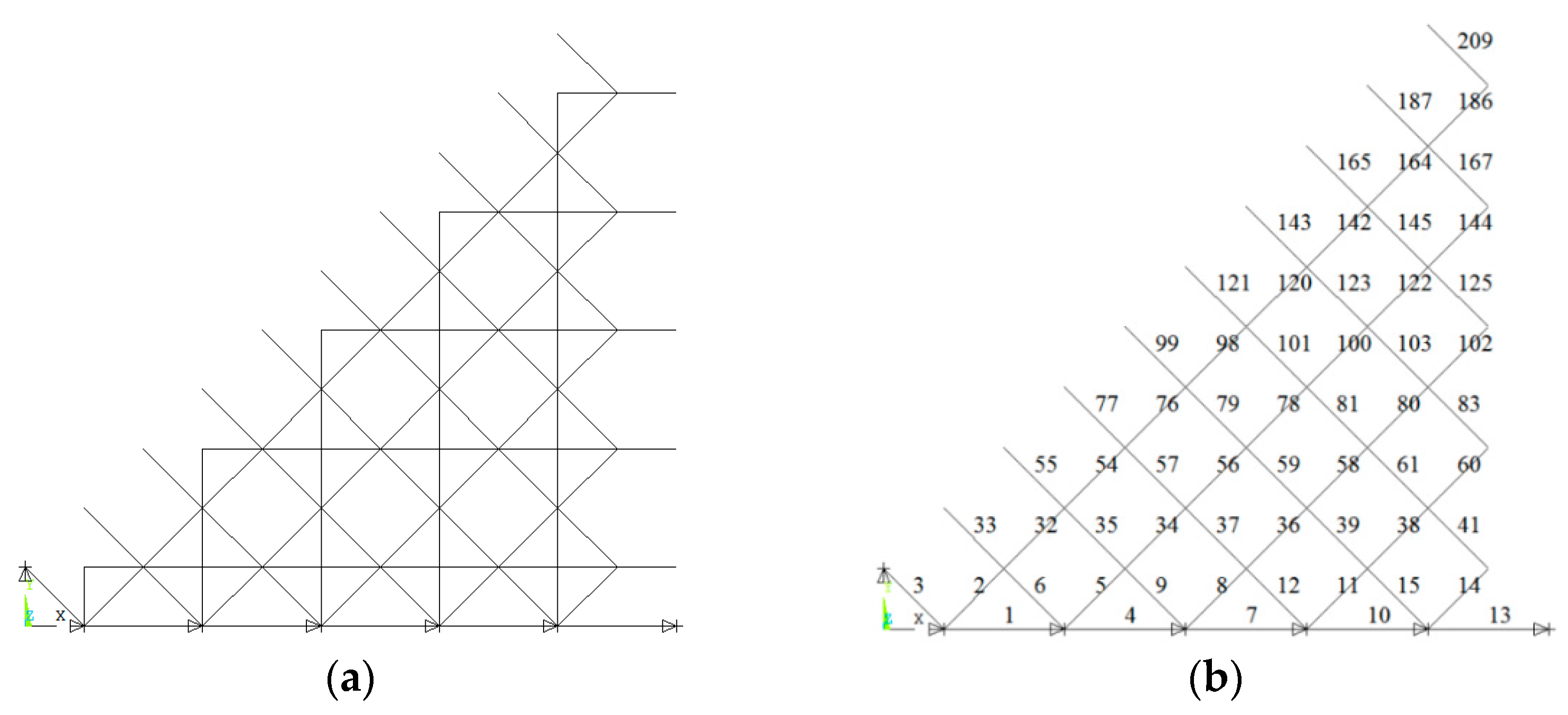
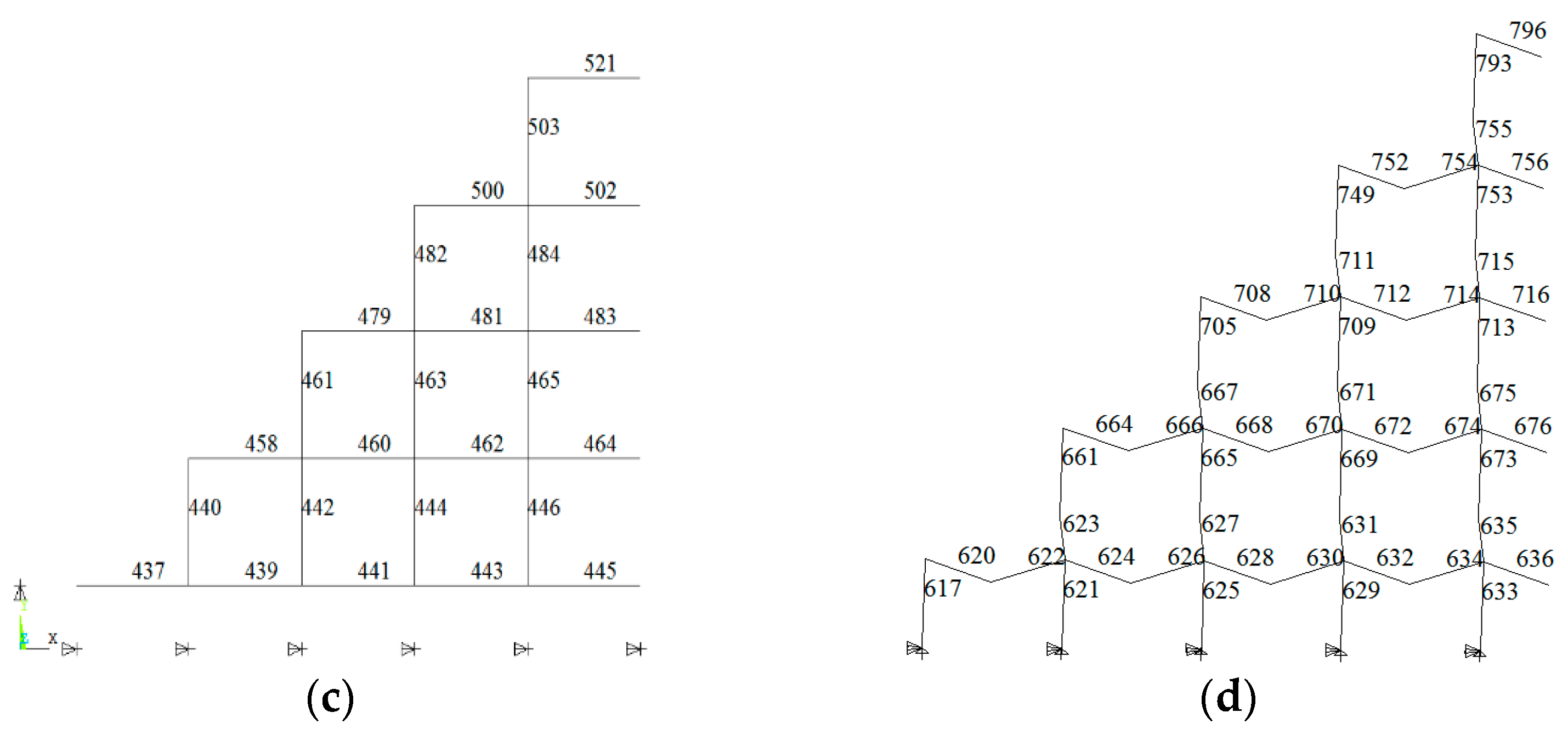
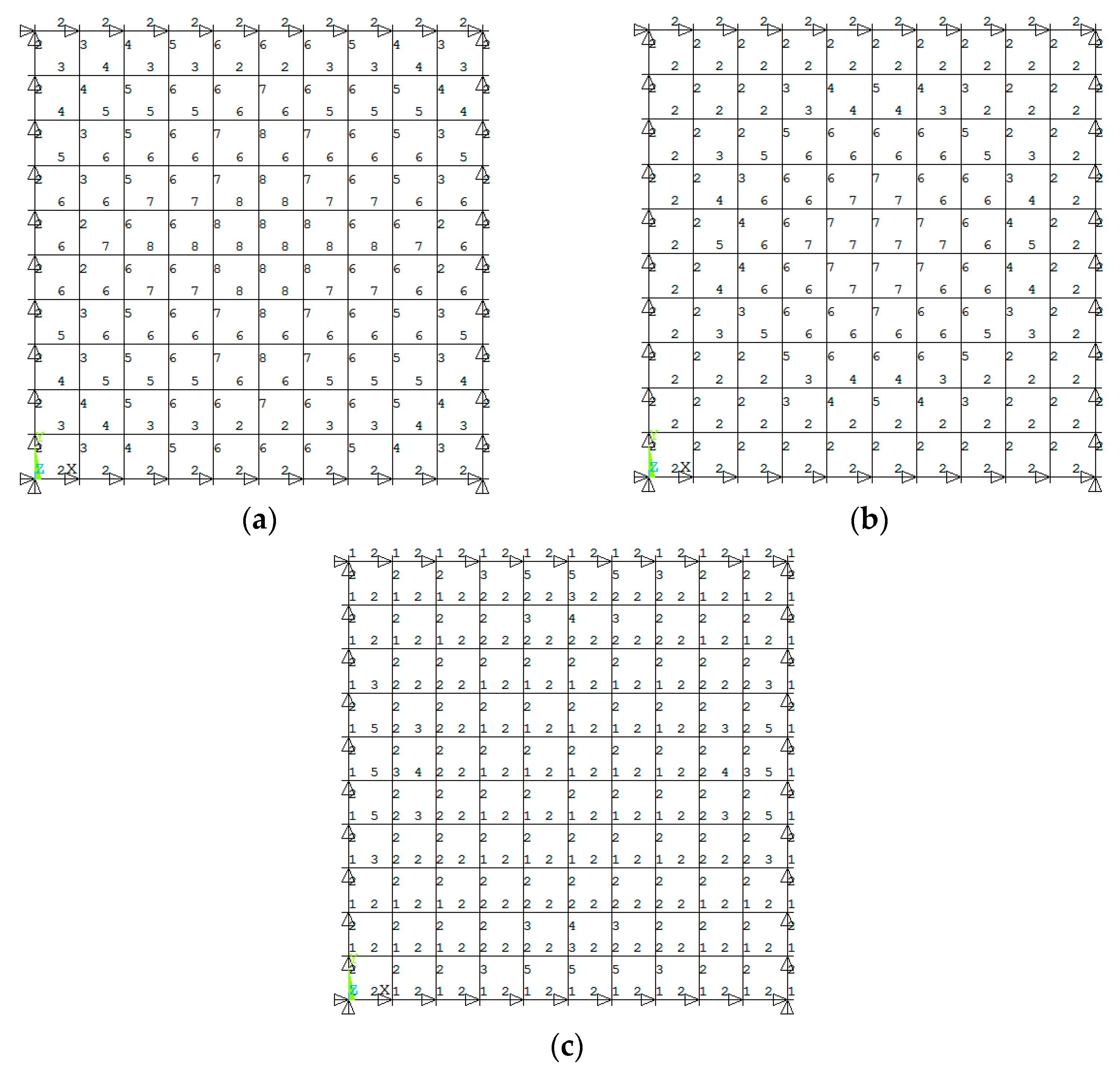


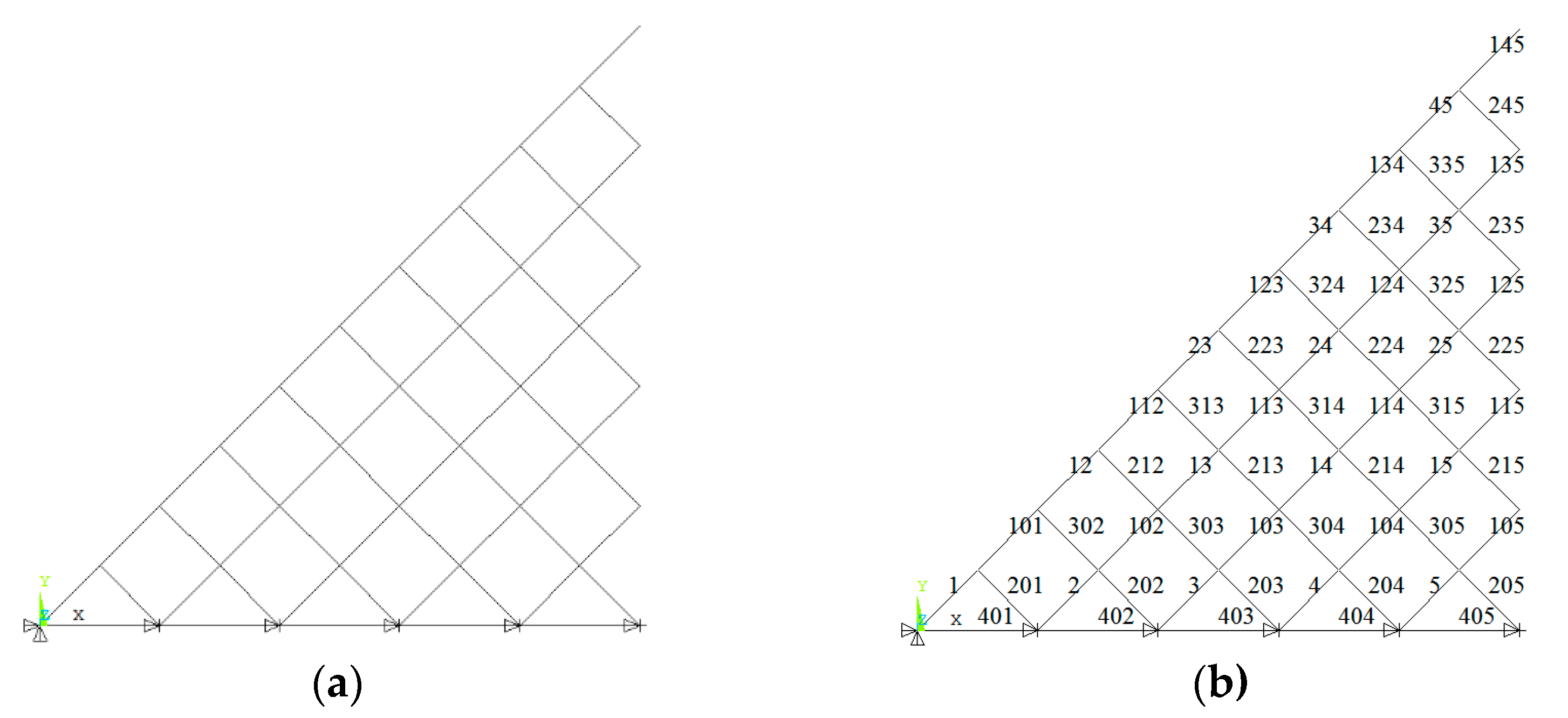

| Element Number | αi | Element Number | αi | Element Number | αi |
|---|---|---|---|---|---|
| 27 | 0.00437 | 228 | 0.00649 | 407 | 0.00113 |
| 29 | 0.00779 | 230 | 0.00766 | 409 | 0.00104 |
| 31 | 0.01024 | 245 | 0.00905 | 410 | 0.00106 |
| 33 | 0.01112 | 246 | 0.00615 | 411 | 0.00160 |
| 47 | 0.00720 | 247 | 0.01391 | 413 | 0.00145 |
| 49 | 0.00929 | 248 | 0.00647 | 414 | 0.00180 |
| 50 | 0.01339 | 249 | 0.01672 | 415 | 0.00204 |
| 51 | 0.01036 | 263 | 0.01308 | 416 | 0.00126 |
| 52 | 0.01802 | 265 | 0.01569 | 417 | 0.00162 |
| 54 | 0.01972 | 266 | 0.02062 | 418 | 0.00223 |
| 70 | 0.01762 | 267 | 0.01658 | 419 | 0.00229 |
| 72 | 0.01982 | 268 | 0.02510 | 420 | 0.00155 |
| 73 | 0.02406 | 284 | 0.02501 | 449 | 0.00106 |
| 75 | 0.02645 | 286 | 0.02652 | 453 | 0.00120 |
| 93 | 0.02722 | 287 | 0.03066 | 455 | 0.00101 |
| 96 | 0.02999 | 305 | 0.03256 | 457 | 0.00117 |
| Element Number | αi | Element Number | αi | Element Number | αi |
|---|---|---|---|---|---|
| 47 | 0.0275 | 261 | 0.0380 | 483 | 0.0075 |
| 66 | 0.0352 | 263 | 0.0390 | 522 | 0.0069 |
| 68 | 0.0465 | 278 | 0.0307 | 523 | 0.0093 |
| 70 | 0.0377 | 280 | 0.0532 | 524 | 0.0089 |
| 87 | 0.0439 | 282 | 0.0553 | 561 | 0.0072 |
| 89 | 0.0587 | 284 | 0.0338 | 562 | 0.0075 |
| 91 | 0.0481 | 297 | 0.0347 | 563 | 0.0103 |
| 108 | 0.0468 | 299 | 0.0608 | 564 | 0.0103 |
| 110 | 0.0628 | 301 | 0.0638 | 584 | 0.0066 |
| 112 | 0.0516 | 303 | 0.0394 | 544 | 0.0066 |
| Element Number | αi | Element Number | αi | Element Number | αi |
|---|---|---|---|---|---|
| 70 | 0.0267 | 116 | 0.0243 | 306 | 0.0314 |
| 72 | 0.0240 | 282 | 0.0329 | 308 | 0.0286 |
| 73 | 0.0247 | 284 | 0.0337 | 418 | 0.0030 |
| 75 | 0.0249 | 285 | 0.0263 | 422 | 0.0032 |
| 89 | 0.0307 | 286 | 0.0268 | 483 | 0.0031 |
| 91 | 0.0358 | 287 | 0.0297 | 522 | 0.0026 |
| 93 | 0.0325 | 289 | 0.0268 | 523 | 0.0039 |
| 94 | 0.0275 | 299 | 0.0292 | 524 | 0.0034 |
| 96 | 0.0281 | 301 | 0.0393 | 561 | 0.0030 |
| 110 | 0.0333 | 303 | 0.0406 | 562 | 0.0030 |
| 112 | 0.0391 | 304 | 0.0276 | 563 | 0.0043 |
| 114 | 0.0356 | 305 | 0.0327 | 564 | 0.0042 |
| Element Number | αi | Element Number | αi | Element Number | αi |
|---|---|---|---|---|---|
| 54 | 0.0010 | 404 | 0.0194 | 416 | 0.0164 |
| 73 | 0.0012 | 405 | 0.0215 | 417 | 0.0219 |
| 75 | 0.0014 | 406 | 0.0205 | 418 | 0.0214 |
| 93 | 0.0014 | 407 | 0.0169 | 420 | 0.0161 |
| 96 | 0.0016 | 408 | 0.0182 | 445 | 0.0221 |
| 268 | 0.0012 | 409 | 0.0217 | 448 | 0.0183 |
| 284 | 0.0012 | 410 | 0.0208 | 449 | 0.0210 |
| 286 | 0.0013 | 411 | 0.0159 | 452 | 0.0168 |
| 287 | 0.0015 | 412 | 0.0170 | 453 | 0.0208 |
| 305 | 0.0016 | 413 | 0.0218 | 456 | 0.0160 |
| 401 | 0.0181 | 414 | 0.0212 | 457 | 0.0208 |
| 403 | 0.0189 | 415 | 0.0155 | 460 | 0.0156 |
| Element Number | Two Edges | Four Edges | Element Number | Two Edges | Four Edges | Element Number | Two Edges | Four Edges |
|---|---|---|---|---|---|---|---|---|
| 2 | 0.0053 | 0 | 96 | 0.0029 | 0.0300 | 298 | 0.0913 | 0.0004 |
| 4 | 0.0087 | 0.0004 | 106 | 0.0068 | 0.0031 | 300 | 0.0548 | 0.0065 |
| 6 | 0.0093 | 0.0013 | 241 | 0.0475 | 0.0002 | 302 | 0.0519 | 0.0166 |
| 8 | 0.0093 | 0.0022 | 260 | 0.0697 | 0.0003 | 304 | 0.0509 | 0.0265 |
| 10 | 0.0093 | 0.0029 | 262 | 0.0402 | 0.0052 | 306 | 0.0506 | 0.0326 |
| 12 | 0.0093 | 0.0031 | 279 | 0.0856 | 0.0004 | 402 | 0.0064 | 0 |
| 64 | 0.0033 | 0.0022 | 281 | 0.0509 | 0.0061 | 406 | 0.0031 | 0.0003 |
| 85 | 0.0058 | 0.0029 | 283 | 0.0481 | 0.0157 | 407 | 0.0030 | 0.0011 |
| 92 | 0.0029 | 0.0198 | 285 | 0.0473 | 0.0250 | 441 | 0.0041 | 0.0005 |
| 94 | 0.0029 | 0.0272 | 287 | 0.0470 | 0.0307 | 442 | 0.0048 | 0.0004 |
| Number of Basic Pyramid Grids | 8 × 8 | 8 × 10 | 8 × 12 | 10 × 10 | 10 × 12 |
|---|---|---|---|---|---|
| Upper chord | 0.0446 | 0.0520 | 0.0511 | 0.0300 | 0.0346 |
| Lower chord | 0.0472 | 0.0554 | 0.0546 | 0.0326 | 0.0377 |
| Web member | 0.0052 | 0.0050 | 0.0046 | 0.0023 | 0.0023 |
| Number of Basic Pyramid Grids | 10 × 16 | 10 × 12 | 10 × 10 | 10 × 8 |
|---|---|---|---|---|
| Upper chord | 0.0228 | 0.0270 | 0.0300 | 0.0361 |
| Lower chord | 0.0234 | 0.0286 | 0.0326 | 0.0394 |
| Web member | 0.0014 | 0.0018 | 0.0023 | 0.0035 |
| Number | 1 | 2 | 3 | 4 | 5 | 6 | 7 |
|---|---|---|---|---|---|---|---|
| Cross-section | Φ60 × 4 | Φ76 × 4 | Φ89 × 4 | Φ114 × 4 | Φ140 × 4 | Φ159 × 6 | Φ159 × 8 |
| Element Number | Element Number | Element Number | |||
|---|---|---|---|---|---|
| 9 | 0.0106 | 145 | 0.0119 | 502 | 0.0559 |
| 12 | 0.0145 | 165 | 0.0105 | 503 | 0.0673 |
| 37 | 0.0135 | 442 | 0.0180 | 521 | 0.0686 |
| 55 | 0.0126 | 444 | 0.0407 | 627 | 0.0184 |
| 57 | 0.0257 | 446 | 0.0414 | 629 | 0.0228 |
| 59 | 0.0242 | 461 | 0.0241 | 631 | 0.0363 |
| 77 | 0.0244 | 463 | 0.0489 | 633 | 0.0226 |
| 79 | 0.0261 | 465 | 0.0527 | 635 | 0.0385 |
| 99 | 0.0347 | 479 | 0.0280 | 661 | 0.0010 |
| 101 | 0.0192 | 481 | 0.0296 | 669 | 0.0250 |
| 103 | 0.0128 | 482 | 0.0542 | 671 | 0.0129 |
| 121 | 0.0148 | 483 | 0.0304 | 673 | 0.0275 |
| 123 | 0.0102 | 484 | 0.0621 | 675 | 0.0174 |
| 143 | 0.0142 | 500 | 0.0558 | 713 | 0.0101 |
| Number | 1 | 2 | 3 | 4 | 5 | 6 | 7 | 8 |
|---|---|---|---|---|---|---|---|---|
| Cross-section | Φ60 × 4 | Φ76 × 4 | Φ89 × 4 | Φ114 × 4 | Φ140 × 4 | Φ159 × 6 | Φ159 × 8 | Φ180 × 8 |
| Upper Chord Number | Lower Chord Number | Web Member Number | |||
|---|---|---|---|---|---|
| 8 | 0.0146 | 73 | 0.0693 | 295 | 0.0667 |
| 10 | 0.0259 | 75 | 0.0855 | 313 | 0.0610 |
| 12 | 0.0313 | 93 | 0.0703 | 316 | 0.0754 |
| 29 | 0.0276 | 96 | 0.0863 | 458 | 0.0257 |
| 31 | 0.0464 | 251 | 0.0247 | 460 | 0.0311 |
| 33 | 0.0552 | 253 | 0.0298 | 481 | 0.0183 |
| 47 | 0.0108 | 270 | 0.0244 | 675 | 0.0174 |
| 50 | 0.0347 | 272 | 0.0412 | 676 | 0.0293 |
| 52 | 0.0616 | 274 | 0.0493 | 677 | 0.0327 |
| 54 | 0.0774 | 290 | 0.0294 | 687 | 0.0199 |
| 70 | 0.0379 | 292 | 0.0331 | 688 | 0.0203 |
| 72 | 0.0360 | 293 | 0.0528 | 721 | 0.2497 |
| Number | 1 | 2 | 3 | 4 | 5 | 6 |
|---|---|---|---|---|---|---|
| Cross-section | Φ60 × 4 | Φ76 × 4 | Φ89 × 4 | Φ114 × 4 | Φ140 × 4 | Φ159 × 6 |
| Upper Chord Number | Lower Chord Number | Web Member Number | |||
|---|---|---|---|---|---|
| 1 | 0.0109 | 314 | 0.0169 | 685 | 0.0130 |
| 201 | 0.0175 | 315 | 0.0103 | 686 | 0.0118 |
| 202 | 0.0204 | 324 | 0.0143 | 695 | 0.0165 |
| 203 | 0.0152 | 463 | 0.0123 | 696 | 0.0145 |
| 212 | 0.0253 | 472 | 0.0165 | 697 | 0.0114 |
| 213 | 0.0205 | 481 | 0.0148 | 705 | 0.0176 |
| 214 | 0.0134 | 543 | 0.0127 | 706 | 0.0162 |
| 223 | 0.0187 | 552 | 0.0131 | 715 | 0.0190 |
| 224 | 0.0129 | 613 | 0.0155 | 767 | 0.0149 |
| 234 | 0.0104 | 614 | 0.0136 | 768 | 0.0187 |
| 302 | 0.0237 | 615 | 0.0105 | 769 | 0.0202 |
| 303 | 0.0223 | 623 | 0.0170 | 778 | 0.0101 |
| 304 | 0.0155 | 624 | 0.0153 | 779 | 0.0104 |
| 313 | 0.0229 | 633 | 0.0186 | 855 | 0.0345 |
Publisher’s Note: MDPI stays neutral with regard to jurisdictional claims in published maps and institutional affiliations. |
© 2022 by the authors. Licensee MDPI, Basel, Switzerland. This article is an open access article distributed under the terms and conditions of the Creative Commons Attribution (CC BY) license (https://creativecommons.org/licenses/by/4.0/).
Share and Cite
Wang, L.; Feng, J.; Xu, Y.; Zhuang, L.; Zhang, Q.; Cai, J. Applications of Energy-Based Evaluation Method of Element Importance to Grid Structures. Symmetry 2022, 14, 370. https://doi.org/10.3390/sym14020370
Wang L, Feng J, Xu Y, Zhuang L, Zhang Q, Cai J. Applications of Energy-Based Evaluation Method of Element Importance to Grid Structures. Symmetry. 2022; 14(2):370. https://doi.org/10.3390/sym14020370
Chicago/Turabian StyleWang, Liwu, Jian Feng, Yixiang Xu, Liping Zhuang, Qian Zhang, and Jianguo Cai. 2022. "Applications of Energy-Based Evaluation Method of Element Importance to Grid Structures" Symmetry 14, no. 2: 370. https://doi.org/10.3390/sym14020370







